
Vega Baja barrio-pueblo is a barrio and downtown area that serves as the administrative center (seat) of Vega Baja, a municipality of Puerto Rico. Its population in 2010 was 816.
The Caguas City Hall consists of two buildings located in the downtown area of Caguas, Puerto Rico.
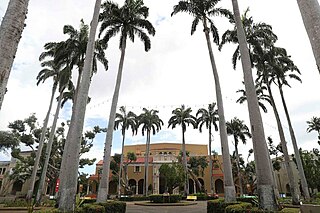
The Quadrangle is the heart and main quadrangle of the University of Puerto Rico, Río Piedras. Together with the Roosevelt Tower, it is listed on the National Register of Historic Places as the University of Puerto Rico Tower and The Quadrangle, for its unique history which represents the union between Puerto Rican architecture with the Jeffersonian Neoclassical style often seen in American universities. It is famous for its lines of Puerto Rican royal palm or palma real and the architecture of its surrounding buildings.
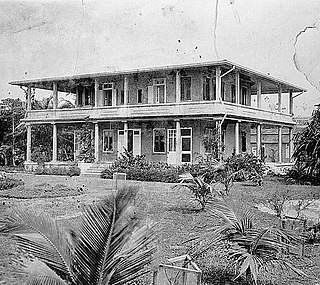
The Superintendent of Lighthouses' Dwelling is an early 20th-century hacienda-style building located in the San Juan Coast Guard Station of La Puntilla in the Marina subdistrict (subbarrio) of Old San Juan. Although the exact date of construction is not known, deteriorated plan drawings of the old United States Naval Base that previously occupied the site of the coast guard station show that the building might have been built either in 1903 or 1908 as part of the regional lighthouses' depot. The building and its surroundings were identified as the Lighthouse Reservation at La Puntilla, with one of its earliest occupants, U.S. Lighthouse Superintendent J. P. Dillon signing and approving plan drawings by the Corps of Engineers. Although the architectural style is inspired in Spanish Revival haciendas found in both private and public buildings the United States, the specific "hacienda-style", as described by the U.S. government survey, was not indigenous nor common in Puerto Rico at the time, and the building and surrounding landscape represents the first design of its kind in the island after 1898.

Villa Del Mar, popularly known as El Castillo, is a historic 1917 residence located in Naguabo, Puerto Rico, in the vicinity of the Malecón of Naguabo.

The Church of Nuestra Señora de las Mercedes de San Miguel de Hato Grande, also known as the Church Las Mercedes of San Lorenzo, is a historic Roman Catholic parish church located in San Lorenzo Pueblo, the administrative and historic center of the municipality of San Lorenzo, Puerto Rico. Las Mercedes was named in honor of both the Virgin Mary and Doña Mercedes Delgado Manso, the wife of the then mayor of San Lorenzo and a descendant of Don Sebastián Delgado Manso, one of the founders of the city of Caguas.
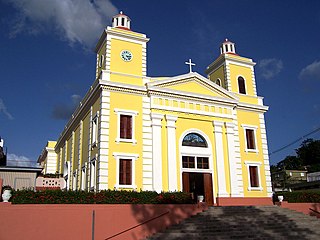
The Church of Saint Michael the Archangel of Utuado is a historic Roman Catholic parish church located in Utuado Pueblo, the administrative and historic center of the municipality of Utuado, Puerto Rico. The church is listed in both the Inventory of the Historic Churches of Puerto Rico and the United States National Register of Historic Places due to its architectural and historical significance.

The Miguel C. Godreau House is a historic residence located in the historic zone of the municipality of Ponce, Puerto Rico. The house was designed by architects Julio Conesa and Julio Morales and was built in 1919. It was listed in the National Register of Historic Places (NRHP) in 1986.

The González Vivaldi Residence is a late 19th-century historic house located in Yauco Pueblo, the administrative and historic center of the municipality of Yauco, Puerto Rico. The house was built in 1880 in the traditional Criollo vernacular style with elements of Neoclassical and Art Nouveau architecture that was typical to the private residences of wealthy landowners of the region at the time. The structure combines masonry and wood, with well-preserved wooden interiors that have not been altered since its construction. The house was added to the National Register of Historic Places in 1987.

Teatro Ideal, also known as La Plaza Theater, is a historic theater and performing arts venue located in the main town square of Yauco Pueblo, the administrative and historic center of the municipality of Yauco, Puerto Rico. The theater was added to the National Register of Historic Places in 1988.
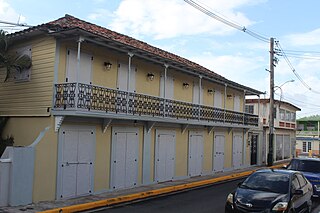
The Machín–Ramos Residence is a historic late 19th-century house located in San Lorenzo Pueblo, the administrative and historic center of the municipality of San Lorenzo, Puerto Rico. The building is the best example of 19th-century Spanish Creole vernacular architecture in San Lorenzo and a good example of this style of architecture in Puerto Rico, with well-preserved examples of this type of building becoming rarer throughout the island in the 20th century.
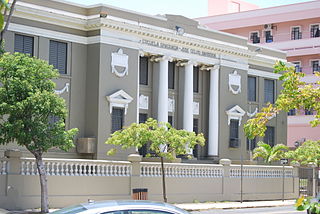
The José Celso Barbosa Graded School is a historic school building located in the Puerta de Tierra historic district in the city of San Juan, Puerto Rico. The school is named after Puerto Rico statehood movement founder Dr. José Celso Barbosa and has been listed in the National Register of Historic Places since 1989. The school was built between 1924 and 1927 and designed by the firm del Valle & Co. in a Neoclassical-style with the intention of making it a public secondary school for recently graduated students from the nearby Brambaugh School. It forms part of the monumental sequence of buildings and memorials that contribute to the Puerta de Tierra Historic District which also includes the Capitol of Puerto Rico.
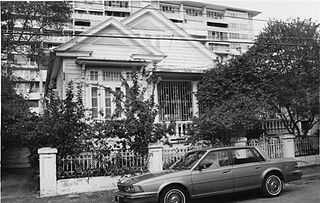
665 McKinley Street is a historic Spanish Creole vernacular-style house located in Miramar, a historic residential area of Santurce in the city of San Juan, Puerto Rico. The house was built in 1906 during a transitional period in the history of architecture in Puerto Rico when the local adaptations of Spanish vernacular styles were transitioning into the Spanish Revival styles that was being imported from the United States and adapted into the tropical environments of the island. The house is well-preserved and retains all elements of this period and, with the exception of the rear balcony, no modifications or alterations that modify the architectural integrity have been made. For this reason, it was added to the National Register of Historic Places in 1991.
The second Delerme-Anduze House, also known as the Rosendo Delerme House at 355 Antonio Mellado Street, is a historic 19th-century Spanish Creole-style house located in Isabel Segunda, the largest and main administrative and historic settlement of the island-municipality of Vieques, Puerto Rico. Local historical accounts such as "The Immigrations to Vieques, 1823-1898", describe the residence as the second house in Vieques to be owned by Augusto Neré Delerme, a wealthy French immigrant from Guadeloupe who built it in 1876 as a wedding gift for his wife Cecilia Anduze, a native of Saint Thomas. The house was lived by their son Julio Delerme-Anduze and afterwards by his descendants. The residence was added to the National Register of Historic Places for its architectural and historical significance as it represents a prime example of Spanish vernacular architecture with elements of the French Creole architecture from the West Indies that was popular in Vieques at the time.
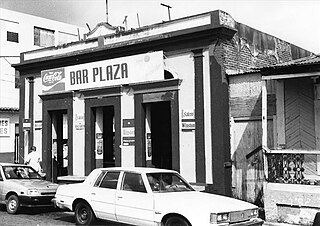
Vieques Pharmacy refers to a historic building that has formerly housed a pharmacy and the main post office of the island-municipality of Vieques, Puerto Rico. The building is located in front of the main town square of Isabel Segunda, the main settlement and administrative center of Vieques. The building is a one-story masonry structure originally intended to be a commercial building. It dates to 1898 when it functioned as a pharmacy, the then called Farmacia de Vieques Liberty Drug underwent remodeling between 1900 and 1903 when the building was under the ownership of Victor Molinary Duteil, a French-Puerto Rican pharmacist and vice-consul of Denmark in Vieques. He was responsible for strengthening the diplomatic and economic ties between Vieques and the then Danish Virgin Islands and later, during and after the Spanish-American War, he helped establish various federal institutions in the island such as a post office and worked as an official translator for the U.S. government until 1910 when he was elected mayor of the island-municipality. Throughout the rest of its history the building continued to serve as a convenience store and as a bar. The building today maintains its architectural integrity and today is the oldest and best-preserved building of its type in Vieques, and the building was added to the National Register of Historic Places in 1994.
The Rafael Acevedo House, also called the Mirella Acevedo Sanes House, is a historic residence located in the town of Isabel Segunda, the largest settlement in the Puerto Rican island-municipality of Vieques. It was designed and built in 1900 by Pedro Peterson, a local engineer and master builder. The residence was added to the National Register of Historic Places in 1994 for being the best-preserved hipped-gable house in Vieques and for being a superb example of the vernacular trends that represent the result of different architectural imports from the British and French West Indies into the Spanish Caribbean.
The Jaime Puig Lemoine Residence, also known as the Carmen Puig Residence, is a historic Bungalow/Craftsman-style house located in the town of Isabel Segunda, the largest settlement in the Puerto Rican island-municipality of Vieques. It was built in 1930 by Catalan and French-Puerto Rican architect Jaime Puig Lemoine in the American Craftsman style, an architectural style that was successfully imported from the United States to Puerto Rico during the first half of the 20th century. It also incorporates elements of Modernism and the local Spanish Creole vernacular architectures. It was added to the National Register of Historic Places in 1994.

The Berta Sepúlveda House is a historic residence located in Sabana Grande Pueblo, the administrative and historic center of the municipality of Sabana Grande, Puerto Rico. It was designed by Mayagüez-native self-made architect Rafael Bofill and built between 1926 and 1927 in a traditional vernacular style with elements inspired by the newly emerging Modern architecture, particularly the Prairie-style. Its most distinctive feature is its wide curved balcony with its Tuscan-style columns. It was added to the National Register of Historic Places in 1994.
The J. J. María le Guillou Tombs, better known as the Guillou Tombs, refers to a historic graveyard consisting of six tombs belonging to the Le Guillou family, the founders of Isabel Segunda, the main town in the island-municipality of Vieques, Puerto Rico. The site, listed in the National Register of Historic Places in 1994, can be found in what is today the Puerto Diablo barrio, just outside of the town of Isabel Segunda. This is the site of a former sugarcane plantation, Hacienda La Pacience, the first of its kind to be established in the island of Vieques. It was established by Teófilo José Jaime María Le Guillou, a Spanish-naturalized French immigrant from Quimperlé, Brittany who is considered the founder of the modern municipality of Vieques. The site today consists of six individual tombs that were built between 1843 and 1855 in a Neoclassical style for the members of the Le Guillou family.
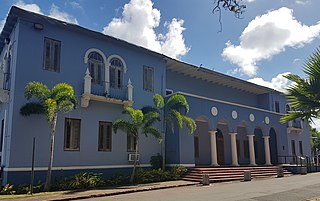
The Ladies Residence Hall of the University of Puerto Rico, Río Piedras, also known today as the Old Residencia de Señoritas Building, is a historic Henry Klumb-designed building and former female dormitory of the University of Puerto Rico, Río Piedras campus (UPRRP). The Residencia de Señoritas was designed by famed architect Henry Klumb, a student of Frank Lloyd Wright, in the Modern style with additional architectural elements inspired in the Spanish Revival style. The building, commissioned by university chancellor Jaime Benítez Rexach, was constructed to accommodate a rapidly increasing student enrollment during a post-World War II developmental period induced by Operation Bootstrap. Although the residence hall was originally intended to be female-only, it became open to both male and female students in the years before the opening of larger residence halls across campus. The building today hosts the administrative and management offices for janitorial and infrastructural services of the UPRRP. It was added to National Register of Historic Places in 2018 due to its distinction as a superb example of International mid-century modern style in Puerto Rico.


















